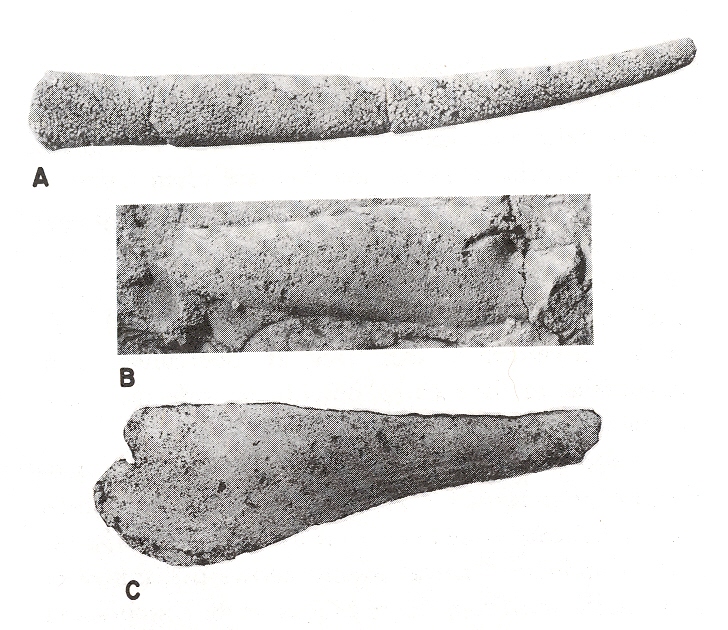
| Palaeos |  |
Rostroconchia |
| Mollusca | The Beak-Shells' Legacy |
| Page Back | Unit Up | Clade Up: Conchifera | Page Next |
| Unit Back | Clade Down: Conocardiida Ribeirioida |
Mollusca References | Unit Next |
|
Abbreviated Dendrogram
MOLLUSCA |--ACULIFERA `--CONCHIFERA |==TRYBLIDIIDA (Monoplacophora) | `--CEPHALOPODA `==HELCIONELLOIDA |--ROSTROCONCHIA | |--+--Conocardiida | | `--+==Ribeirioida | | `--SCAPHOPODA | `--BIVALVIA `--GASTROPODA |
Contents
Overview |

Specimen of Conocardium japonicum, from here.
The Rostroconchia were a group of molluscs that lived during the Palaeozoic, being definitely found from the Late Cambrian to the latest Permian. The name means, roughly, 'beak-shell', and refers to the shape of the shell. Similar to bivalves (with which rostroconchs were classified prior to the 1970s), rostroconchs had a shell divided into left- and right-hand valves, which in many species were elongate in one or both directions forewards and backwards. The shells of different species gaped to varying degrees at the posterior and anterior ends. Rostroconchs differed from bivalves, however, in that the original larval shell was not divided. Instead, the shell of a rostroconch was initially cap-shaped and entire. As the animal developed past the larval stage, the shell developed lateral lobes that would eventually become the two valves. As a result, rostroconchs did not have a toothed hinge connecting the valves like that of bivalves. Nevertheless, in many species, the pressure of the valves growing outwards eventually caused the larval shell to break through (Pojeta & Runnegar 1976). Like many bivalves, rostroconchs would have been infaunal, living buried in the sediment; however, the absence of a toothed hinge or the adductor muscles that connect the valves in bivalves means that the shell of rostroconchs would have been less flexible.

The Ordovician scaphopod Rhytiodentalium (topmost image) and the scaphopod-like rostroconch Pinnocaris (lower two images), from here.
The largest work to date on rostroconchs was that of Pojeta & Runnegar (1976), who suggested that rostroconchs included the ancestors of two living classes of molluscs, the bivalves and the scaphopods. Scaphopods, tusk-shells, are a group of tubular molluscs with an opening at each end of the tube that also live buried in sediment. According to Pojeta & Runnegar's suggestion, the bivalves evolved through the evolution of two calcification centres in the larval stage. The scaphopods would have evolved through the fusion of the valves along the ventral margin (as embryological studies have shown the scaphopod shell does develop), together with the restriction of growth to the anterior direction only.
However, more recent studies of molluscan phylogeny (Wilson et al. 2010) have mostly indicated that bivalves and scaphopods are not closely related relative to other molluscs. Bivalves are probably a relatively basally derived group, while scaphopods are closer to cephalopods. The upshot of this for rostroconchs is that they may be related to bivalves or scaphopods, but not to both. Of the two, it seems more likely that rostroconchs are related to scaphopods (or, as some authors have put it more bluntly, scaphopods are living rostroconchs). As well as the anatomical arguments that have been made in favour of such a relationships, a scaphopod connection has the advantage over a bivalve one of stratigraphy. The oldest definite rostroconchs, as previously noted, are known from the Late Cambrian. However, the oldest definite bivalves come from the Early Cambrian—that is, some 40 or 50 million years earlier than the first known rostroconchs. Scaphopods, on the other hand, do not appear until the Ordovician or Devonian (depending on whether the earlier forms are accepted as scaphopods), well after the known appearance of their supposed ancestors. Pojeta & Runnegar (1976) did not recognise a stratigraphic conflict in deriving bivalves from rostroconchs as they had identified the Early Cambrian Heraultipegma as a rostroconch. This identification, however, was disputed by MacKinnon (1985), who held that the characters cited by Pojeta & Runnegar in support of their assignation had been misinterpreted and were not truly present in Heraultipegma.

The conocardioid rostroconch Arceodomus longirostris, from here.
Pojeta & Runnegar (1976) recognised three orders of rostroconch: the Ribeirioida, Ischyrinioida and Conocardioida. This division has been followed by all subsequent authors, though it should be noted that Pojeta & Runnegar recognised the Ribeirioida as explicitly paraphyletic with regard to the other orders. Pojeta & Runnegar (1976) regarded the scaphopods as derived from ribeirioids (specifically related to the somewhat scaphopod-like Pinnocaris), but Peel (2004) stated that protoconch characters indicated a derivation from conocardioids. The ribeirioids and ischyrinioids both became extinct at the end of the Ordovician, leaving only the conocardioids and their descendent scaphopods until the former also became extinct at the end of the Palaeozoic.
References
MacKinnon, D. I. 1985. New Zealand late Middle Cambrian molluscs and the origin of Rostroconchia and Bivalvia. Alcheringa 9 (1): 65-81.
Peel, J. S. 2004. Pinnocaris and the origin of scaphopods. Acta Palaeontologica Polonica 49 (4): 543-550.
Pojeta, J., Jr & B. Runnegar. 1976. The paleontology of rostroconch molluscs and the early history of the phylum Mollusca. U.S. Geological Survey Professional Paper 968: 1–88.
Wilson, N. G., G. W. Rouse & G. Giribet. 2010. Assessing the molluscan hypothesis Serialia (Monoplacophora + Polyplacophora) using novel molecular data. Molecular Phylogenetics and Evolution 54 (1): 187-193.
| Page Back | Unit Home | Page Top | Page Next |
Text © CKT110808; images © their respective owners.